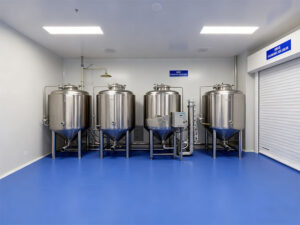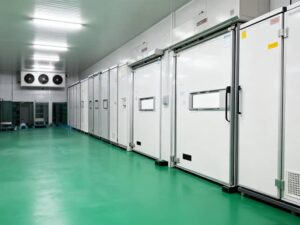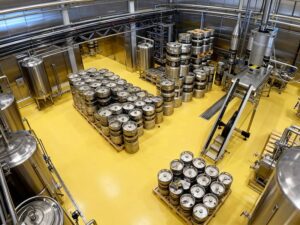I. Introduction
(1) Importance of Surface Preparation in Engineering Projects
In large – scale engineering projects, surface preparation is a crucial step that has a profound impact on the quality and durability of the entire painting work. For micaceous iron oxide paint, correct surface preparation is even more essential. Good surface preparation can ensure that the paint fully combines with the substrate surface, forming a tight and continuous protective layer. If the surface preparation is improper, the paint may not adhere firmly to the substrate, and problems such as peeling and flaking may occur, greatly reducing the protective effect of the paint.
In the long run, proper surface preparation can reduce the frequency of subsequent maintenance and repairs, thus lowering the overall cost of the engineering project. For example, in bridge construction, if the surface preparation work is not done well, the paint will失效 in a short time. The steel structure of the bridge will be exposed to harsh environments, accelerating the corrosion process. Frequent repainting and repairs will be required, which not only increases the project cost but also affects the normal use of the bridge.
(2) Overview of Micaceous Iron Oxide Paint
Micaceous iron oxide paint is a high – performance protective paint that uses micaceous iron oxide as the main pigment. Micaceous iron oxide is a natural mineral with a unique flaky structure. This flaky structure enables the paint to form overlapping barriers after application, effectively preventing the intrusion of moisture, oxygen, and other corrosive substances, thereby providing excellent anti – corrosion protection for the substrate.
Micaceous iron oxide paint has a wide range of applications in engineering projects. In the field of marine engineering, such as offshore oil platforms, it can resist the erosion of seawater and the harsh conditions of high humidity and high salt content in the marine environment. In industrial buildings, for some chemical plants, power plants, etc., it can protect steel structures and concrete structures from the corrosion of chemical substances and the erosion of the atmosphere. In bridge construction, it can provide long – term protection for the steel structure of the bridge, extending the service life of the bridge.
II. Surface Pre – Inspection
(1) Visual Inspection
Before starting the surface preparation, a comprehensive visual inspection should be carried out first. The purpose of this step is to identify various problems on the surface and provide a basis for subsequent treatment.
The inspection includes checking for the presence of existing coatings. If there is an old coating on the surface, its condition needs to be evaluated. If the old coating has serious problems such as peeling, flaking, and powdering, it may need to be completely removed. If the old coating is in good condition, appropriate treatment such as sanding and cleaning can be carried out according to the specific situation to ensure better adhesion of the new paint.
At the same time, it is necessary to check for contaminants such as rust, scale, and dirt on the surface. Rust can affect the adhesion of the paint and continue to corrode the substrate. Scale may gradually fall off after the paint is applied, leading to coating failure. Dirt can hinder the combination of the paint and the substrate, reducing the protective effect. In addition, attention should be paid to the presence of damage on the surface, such as dents and scratches. These damages may affect the flatness and protective performance of the paint and require corresponding repairs.
(2) Surface Roughness Assessment
Surface roughness has an important impact on the adhesion of the paint. Appropriate surface roughness can increase the contact area between the paint and the substrate, improving the mechanical anchoring force and thereby enhancing the adhesion effect of the paint. If the surface is too smooth, the friction between the paint and the substrate is small, and sliding and peeling are likely to occur. On the other hand, if the surface is too rough, it may be difficult for the paint to fill the gaps on the surface during application, forming voids and affecting the protective performance.
There are various methods to measure surface roughness. Among them, using a surface profilometer is a relatively accurate and commonly used method. A surface profilometer can accurately obtain the surface roughness value by measuring the microscopic shape and height changes of the surface. During the measurement, multiple measurements should be taken at different positions to ensure the accuracy and representativeness of the measurement results. Based on the measurement results, it can be determined whether the surface roughness meets the requirements of the paint. If not, corresponding measures should be taken for adjustment.
III. Surface Cleaning
(1) Removal of Loose Debris
Removing loose debris on the surface is the first step in surface cleaning. These loose debris include dust, soil, sand particles, etc., which can affect the combination of the paint and the substrate.
There are several common removal methods. Brushing can be used for cleaning. The choice of brush depends on the material of the surface and the size of the debris. For larger debris, a hard – bristled brush can be used for sweeping. For fine dust, a soft – bristled brush can be used for cleaning. Vacuuming is also an effective method. It can suck away the dust and fine particles on the surface, keeping the surface clean. In addition, compressed air can be used for blowing. High – pressure air can blow away the debris on the surface. When using compressed air, the air pressure and blowing angle should be controlled to avoid damaging the surface.
(2) Degreasing Treatment
Degreasing treatment is an important step in removing oil, grease, and other contaminants from the surface. Oil and grease can form a film on the surface, hindering the direct contact between the paint and the substrate and reducing the adhesion of the paint. At the same time, these contaminants may also react chemically with the paint, affecting the performance of the paint.
Different types of surfaces require different degreasers. For steel surfaces, organic solvent – based degreasers such as acetone and alcohol can be used. These degreasers have strong dissolving abilities and can quickly remove the oil on the surface. When using them, apply the degreaser to the surface and then wipe it clean with a clean cloth. For concrete surfaces, alkaline degreasers such as sodium hydroxide solution can be used. Alkaline degreasers can react with oil through saponification, decomposing and removing the oil. When using alkaline degreasers, the concentration and treatment time should be controlled to avoid corroding the concrete surface.
(3) Rust Removal
For steel surfaces, rust removal is one of the key steps in surface preparation. Rust will continuously corrode the steel, reducing its strength and durability. If the rust is not removed in time, the paint cannot adhere effectively to the steel surface, and the protective effect will be greatly reduced.
The rust removal methods are mainly divided into mechanical and chemical methods. Mechanical methods include sandblasting, wire brushing, etc. Sandblasting is a commonly used rust removal method. It removes rust and scale by high – speed spraying of abrasives (such as quartz sand, steel sand, etc.) onto the steel surface. Sandblasting can create a certain roughness on the steel surface, which is beneficial for the adhesion of the paint. Wire brushing involves using a wire brush to rub the steel surface to remove rust. This method is suitable for rust removal and surface treatment of small areas.
Chemical methods mainly involve using rust removers. Rust removers are usually acidic solutions that can react chemically with rust, dissolving and removing it. Common rust removers include hydrochloric acid and sulfuric acid. When using chemical rust removers, the concentration and treatment time should be controlled to avoid excessive corrosion of the steel surface. After use, the surface should be rinsed thoroughly with clean water to prevent the residue of the rust remover from having an adverse effect on the paint.
IV. Surface Profiling
(1) Mechanical Profiling
Mechanical profiling is a physical method to change the microscopic structure of the surface to improve the adhesion of the paint. In steel surface treatment, sandblasting is a commonly used mechanical profiling method.
During the sandblasting process, the abrasives impact the steel surface at high speed. This not only removes rust and scale but also creates an uneven microscopic structure on the steel surface. This microscopic structure increases the contact area between the paint and the steel surface, improving the mechanical anchoring force. Different types of abrasives have different effects on the surface. Quartz sand is hard and can produce a relatively large roughness, but it may leave some small scratches on the surface. Steel sand has good toughness and wear resistance and can form a more uniform roughness.
When performing sandblasting operations, parameters such as the sandblasting pressure, abrasive flow rate, and spraying angle need to be controlled. Excessive pressure may damage the steel surface, while insufficient pressure may not achieve the desired surface roughness. An excessive abrasive flow rate may cause waste, while an insufficient flow rate may not fully treat the surface. An improper spraying angle may result in uneven surface treatment.
(2) Chemical Profiling (if applicable)
In some cases, chemical treatment can also be used for surface profiling, especially for some non – metallic surfaces. The principle of chemical profiling is to change the chemical properties and microscopic structure of the surface through chemical reactions, thereby improving the adhesion of the paint.
For example, for concrete surfaces, chemical treatment agents can be used. These treatment agents can react with the components in the concrete, forming an active layer on the surface and increasing the bonding force between the paint and the concrete surface. The advantage of chemical profiling is that it can improve the surface performance without destroying the original structure of the surface. However, it should be noted that the selection and use of chemical treatment agents should be reasonably matched according to the specific surface material and paint type to avoid adverse reactions.
V. Surface Repair
(1) Filling Holes and Cracks
Holes and cracks found during the surface inspection need to be filled in a timely manner. These holes and cracks can affect the flatness and protective performance of the paint and may become channels for the intrusion of moisture and corrosive substances.
For different surface materials, suitable filling materials should be selected. For concrete surfaces, epoxy – based fillers are commonly used. Epoxy – based fillers have good bonding performance and durability and can closely combine with the concrete to fill holes and cracks. When filling, first clean the holes and cracks to remove dust and debris. Then, prepare the filler according to the specified ratio and fill it into the holes and cracks. After filling, use tools to smooth the surface to make it level with the surrounding area.
For steel surfaces, epoxy – based fillers can also be used for filling. In addition, some metal filling materials such as iron powder and aluminum powder can be mixed with an appropriate binder for filling. After filling, grinding and treatment should be carried out to make the surface smooth and flat for subsequent paint application.
(2) Repairing Damaged Areas
For severely damaged areas, such as large – scale corrosion and damaged steel components, more thorough repairs are required.
If the damaged area is small, a local repair method can be adopted. For steel components, the damaged part can be cut and replaced, and then welding and grinding can be carried out to restore its original shape and performance. During the welding process, attention should be paid to the welding quality to avoid welding defects. After welding, the welded part should be ground and treated to make the surface smooth so that the paint can be evenly applied.
If the damaged area is large, the entire component may need to be replaced or reinforced. When replacing the component, it is necessary to ensure that the material and specifications of the new component are the same as the original one and that it is installed firmly. When reinforcing the component, methods such as adding support structures or pasting steel plates can be used to improve the bearing capacity and stability of the component. After the repair is completed, the entire surface should be re – treated, including cleaning, grinding, and painting, to ensure the protective effect.
VI. Final Inspection
(1) Re – Inspection
After completing all the surface preparation steps, a final re – inspection should be carried out. The purpose of this step is to ensure that the surface has met the requirements for paint application.
The re – inspection content is similar to the pre – inspection but more detailed and strict. It is necessary to check again for the presence of residual dirt, rust, grease, and other contaminants on the surface. If any residual contaminants are found, they should be cleaned in a timely manner. At the same time, check whether the surface roughness meets the requirements, whether the holes and cracks have been filled evenly, and whether the damaged areas have been repaired properly. Also, check the flatness of the surface to ensure that there are no obvious unevenness.
(2) Surface Cleanliness and Dryness
The cleanliness and dryness of the surface are important indicators before paint application. A clean surface can ensure good bonding between the paint and the substrate, and a dry surface can prevent problems such as blistering and whitening after the paint is applied.
When checking the surface cleanliness, a clean white cloth can be used to wipe the surface. If there are no obvious stains on the white cloth, it indicates that the surface cleanliness meets the requirements. For checking the surface dryness, a moisture meter can be used for measurement. Generally, the surface moisture should be below a certain standard before paint application. Different types of paints may have different requirements for surface moisture. Therefore, before applying the paint, the paint instruction manual should be carefully read to ensure that the surface moisture meets the requirements.
VII. Conclusion
(1) Summary of Key Points
In summary, before applying micaceous iron oxide paint, surface preparation work includes multiple steps such as pre – inspection, cleaning, profiling, repair, and final inspection. Pre – inspection can identify problems on the surface and provide a basis for subsequent treatment. Cleaning work can remove contaminants on the surface, ensuring good bonding between the paint and the substrate. Surface profiling can improve the adhesion of the paint. Repair work can solve the damage problems on the surface. The final inspection can ensure that the surface meets the requirements for paint application.
(2) Benefits of Proper Surface Preparation
Proper surface preparation is of great significance for the performance of micaceous iron oxide paint and the long – term benefits of engineering projects. It can improve the adhesion of the paint, enabling it to firmly adhere to the substrate and form a continuous and tight protective layer, effectively preventing the intrusion of moisture, oxygen, and other corrosive substances, and providing excellent anti – corrosion protection for the substrate.
From an economic perspective, proper surface preparation can reduce the cost of subsequent maintenance and repairs. Since the paint can function effectively for a long time, the frequency of repainting and repairs is reduced, lowering the overall cost of the engineering project. From a social perspective, it can extend the service life of the engineering project, improve the safety and reliability of infrastructure, and provide保障 for social development and people’s lives.
In conclusion, in engineering projects, attaching importance to and doing a good job in surface preparation is the key to ensuring the protective effect of micaceous iron oxide paint and an important measure for achieving the sustainable development of engineering projects.







